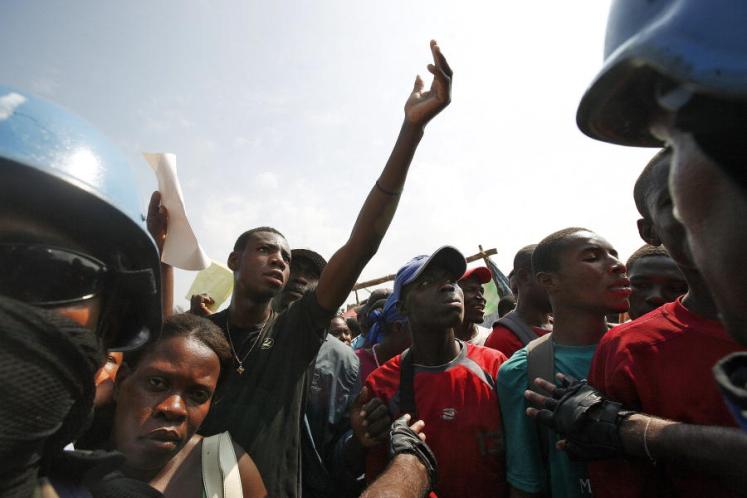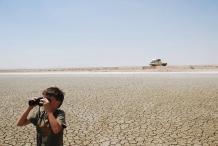While conflict-related risks such a forced labour, organ trafficking, and sexual slavery are a threat to all civilians during wartime, vulnerability is most often assigned to women or children. The idea that men require protection is often resisted by societies, and by some men themselves, and there’s a risk that during crises, despite being potential victims, men are ‘unseen’ in protective efforts. Risks can be particularly high for men from marginalized communities, including refugees and migrants and those who are homeless, of diverse sexual orientation, gender identity and expression (SOGIESC), and Black or from another racial minority group.
An exclusive focus on women and children, our research has found, can hinder a more comprehensive analysis of vulnerability and diversity, meaning that the modern slavery risks men face are largely unappreciated in data, practices, policy, and funding, even when they are pervasive.
In recent years we have seen this play out in different conflict settings – from Ukraine and Haiti to Palestine and Sudan – where prevailing gender norms, popular notions of victimhood, and exclusionary protection measures conspire to expose men to the prey of traffickers and criminal gangs.
Gendered Vulnerability
Our analysis of international anti-trafficking policy and research in Haiti and Poland uncovered numerous instances of men’s protection needs being overlooked. Across Europe, for instance, there was a rapid response to identify and reduce the exposure of displaced Ukrainian women and children to trafficking and exploitation, but no equivalent action was immediately taken for displaced men, even if they were exempt from Ukrainian conscription.
Under the EU Temporary Protection Directive the right to access basic banking – a critical defence against exploitation and modern slavery – assisted mainly Ukrainian women who were able to open accounts with reduced identification requirements. Men were not the priority of these efforts, since those aged 16 to 60 years were subject to conscription, and initially, male third country nationals fleeing Ukraine were not included.
Our research indicated that men consequently resorted to unconventional financial practices, including cryptocurrencies and engaging in unregulated online transactions, which exposed them to risk. By 2023, there was a significant increase of men, especially ‘foreigners,’ contacting the Ukrainian trafficking hotline, highlighting the need for protective actions.
Elsewhere, in Haiti, where there is a protracted and serious environmental, social, and political crisis, recent reports suggest that Haitian boys and young men are experiencing forced criminal exploitation and alarmingly high levels of sexual violence, including UN documented cases of diverse SOGIESC individuals and boys being sexually assaulted by gang members.
Yet, key participants in our research stated that anti-trafficking policy is exclusively focused on women and girls, leaving many male victims without support. Haitian society was depicted as tending to view women as more vulnerable and prone to violence in trafficking situations, thus overshadowing the plight of men. Some participants were surprised by the study's focus on men, though often this was not out of malice but due to the previous priority given to women.
Currently in Palestine, anti-slavery protection responses for all civilians are severely challenged – and the risks of exploitation while war rages are incredibly high. When war broke out, Palestinian workers, mainly men, were expelled from manual and agricultural sectors in Israel and the occupied territories, where labour exploitation was already a concern. Employers then rushed to fill the vacancies with overseas labour.
These actions plummeted workers and their families into destitution – a situation that deteriorated even further during the widespread destruction of Gaza and the reduced access to food and aid that many men and boys – regardless of injuries sustained or the risk to their lives – perceived as their responsibility to obtain.
Closing the Protection Gap
These examples demonstrate that protection responses – when men are displaced (internally and externally), when conflicts end, and countries rebuild – need to be long term and address gendered stereotypes of vulnerability to ensure that intersectional risks to different forms of exploitation are understood and reduced.
Fortunately, it appears that the protection gap neglecting the needs of men during crises is beginning to be taken more seriously. This week’s Security Council annual open debate will consider the protection of civilians in armed conflict and crisis situations, and there are signs that discussions are becoming more inclusive to consider how identity, including gender, shapes vulnerability and influences the barriers people face when accessing protection.
To close the protection gap, international humanitarian and private sector actors must challenge and dismantle the gendered stereotypes that have long dominated discussions of vulnerability to modern slavery and financial exclusion. To not do so, in such fragile settings, we risk not just reinforcing but creating vulnerability to exploitation and abuse. Below, we outline several recommendations, based on our research, to help inform policy and practice moving forward:
- Improve understanding of modern slavery in conflict/crisis settings: to help overcome the stereotypes of ‘trafficking’ victims, often related to gender and migration.
- Expand notions of ‘gender’: a deeper understanding of the lived experience of gender is critical to creating effective, needs-led anti-slavery and financial inclusion policies and responses.
- Integrate anti-slavery responses into conflict and crisis protection interventions: these should be fully inclusive of the range of modern slavery risks affecting different genders and enable different and gender-specific solutions to be created.
- Better integrate financial access within anti-slavery/anti-trafficking protection policy: in particular, to engage the financial sector more actively in initial and long-term humanitarian responses, especially to enable financial access for affected populations, a key defence against modern slavery.
- Monitor and evaluate interventions to improve knowledge of gender and financial vulnerabilities to modern slavery: to enable a better understanding of gendered modern slavery risks, protection needs, and the impact and efficacy of policy interventions on diverse demographic groups.
The issues covered in this blog will be discussed at a side-event with All Survivor’s Project during Protection of Civilians Week on 22 May. The blog has also been informed by a UNU-CPR Research Report, "Modern Slavery and Financial Exclusion: Exploring Crisis-Related Risks for Men."
Suggested citation: Leona Vaughn, Smith Angharad., "Protecting Civilians in War—Why Men Shouldn't Be Forgotten," UNU-CPR (blog), 2024-05-21, 2024, https://unu.edu/cpr/blog-post/protecting-civilians-war-why-men-shouldnt-be-forgotten.



